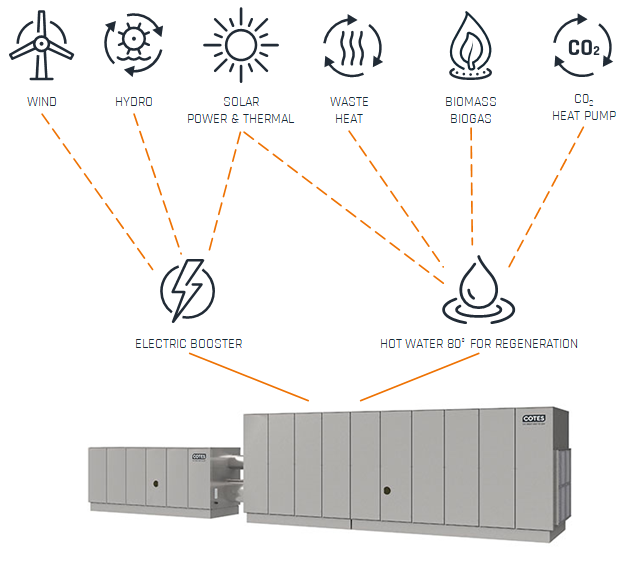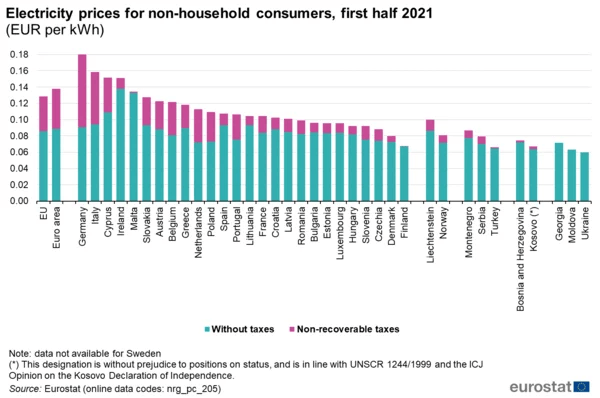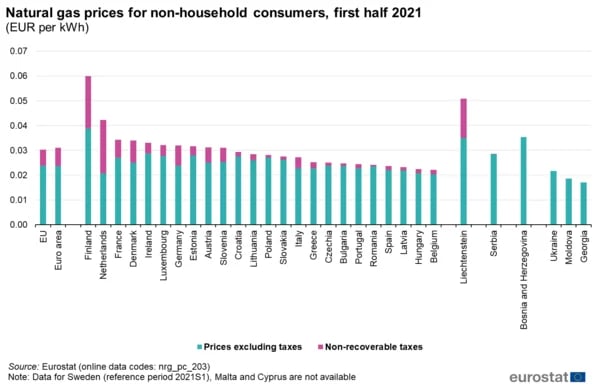For a recent project proposal for a client in Western Europe, Cotes made an analysis of the cost and carbon emissions savings you could achieve for a battery dry room in western Europe IF you chose to use Cotes Exergic Technology instead of conventional gas and electric-only solutions.
Battery dry room using Cotes Exergic technology
 With Cotes Exergic Technology, you can utilise a combination of sustainable energy sources to achieve considerable energy cost savings and a large carbon footprint reduction in your battery dry room. In order for Cotes Exergic Technology to work, all you need is hot water heated by a sustainable energy source.
With Cotes Exergic Technology, you can utilise a combination of sustainable energy sources to achieve considerable energy cost savings and a large carbon footprint reduction in your battery dry room. In order for Cotes Exergic Technology to work, all you need is hot water heated by a sustainable energy source.
Below is a break-down of the energy cost and CO2 savings you can make using the Cotes Exergic Technology.
NOTE: The calculations below may differ for you depending on your local energy costs and available sources of energy. For a more detailed analysis of your battery dry room, please consult the Cotes team for a custom calculation or try the free online CO2 reduction calculator.
The calculations below use conventional gas as the baseline index of 100. Energy prices at the time of calculation are listed below.
| A Battery Dry Room in Western Europe | Cost of energy | CO2 | Cost Index | CO2 Index |
| EUR/yr | tonnes/yr | |||
| Conventional non-Cotes gas and electric installations |
||||
| Conventional, gas | 2.265.381 | 8.467 | 100% | 100% |
| Conventional, electricity | 5.059.288 | 2.829 | 223% | 33% |
| Cotes Exergic Technology using a combination of sustainable energy sources | ||||
| Exergic, Waste Heat, electric boost | 776.841 | 464 | 34% | 5% |
| Exergic, solar heat, electric boost | 2.124.900 | 1.196 | 94% | 14% |
| Exergic, heat pump, electric boost | 2.089.344 | 1.134 | 92% | 13% |
| Exergic, gas** | 1.863.583 | 6.866 | 82% | 81% |
**Cotes does not recommend or consider gas as a sustainable source of energy due to the environmental footprint. We recommend utilising energy for the hot water from sustainable or “green” energy sources instead. However, if gas is a requirement, the hot water can come from a central gas boiler.
From a EURO cent per kWh perspective, if you have an available waste heat energy source that you can utilise, like the baking process of Li-ion battery cells, then you essentially have a "free" energy source that would otherwise have gone to waste. In this case, you can save energy costs and reduce carbon emissions at the same time.
Furthermore, the Cotes Exergic Technology runs optimal conditions on temperature margins of 80-90°C, significantly lower than the closest competitors' solutions that run optimal conditions at 140-180°C. That is why Cotes solution allows for lower energy consumption and better safety margins at lower temperatures.
| Client's Local Energy Prices (Aug 2021) | EUR Cent/kWh |
| Electricity Price | 10,50 |
| Gas Price | 3,40 |
| Cooling Price | 1,67 |
| Exergic, Waste, electric boost | 0,00 |
| Exergic, solar heat, electric boost | 4,20 |
| Exergic, heat pump, electric boos | 4,63 |
| Exergic, gas** | 3,40 |
| CO2 | kg/kWh |
| CO2 kg/kWh Electricity | 0,06 |
| CO2 kg/kWh Gas | 0,20 |
| CO2 Cooling | 0,01 |
| CO2 Exergic, Waste | 0,00 |
| CO2 Exergic, solar heat | 0,02 |
| CO2 Exergic, heat pump | 0,03 |
| CO2 Exergic, gas** | 0,20 |
Compare other European countries and their electricity and gas prices below. Prices are from the first half 2021 and could vary from current energy prices.
|
If you are a car or battery manufacturer that wants to go green(er) and save costs, then reach out to us. Cotes can help you find the right dry-air solution for your facilities and give you the competitive advantage of a more sustainable Li-ion battery. Contact Global Manager Battery & Country Manager France for more information at jvi@cotes.com. |
|
Are you curious about the potential energy savings for your battery dry rooms? Take a look at our free online calculator below.




.webp)